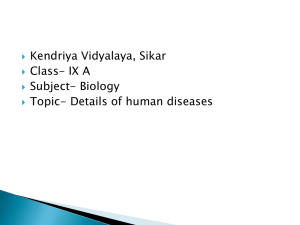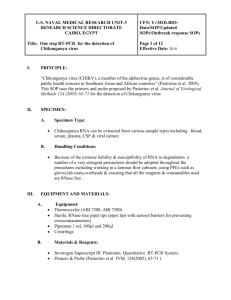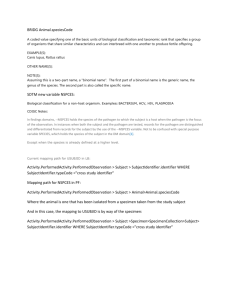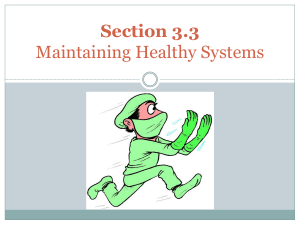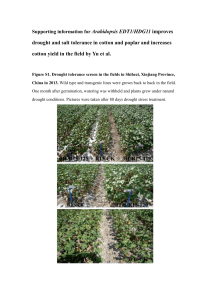SOP: RT-PCR, qRT-PCR for Chikungunya Virus
advertisement
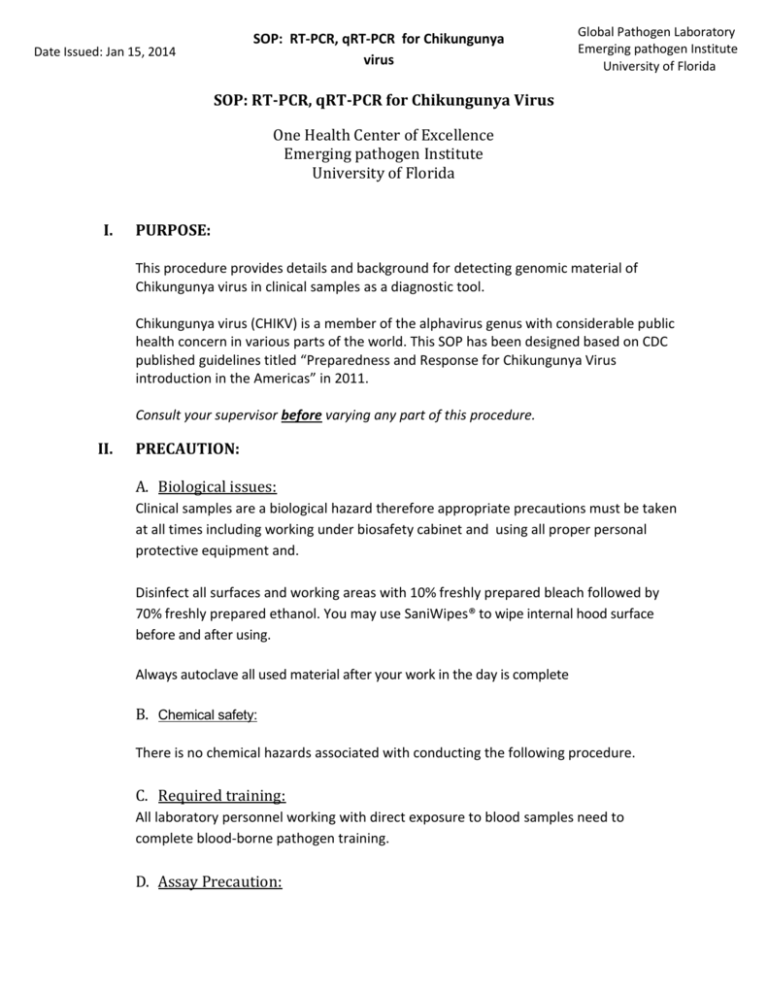
SOP: RT-PCR, qRT-PCR for Chikungunya virus Date Issued: Jan 15, 2014 Global Pathogen Laboratory Emerging pathogen Institute University of Florida SOP: RT-PCR, qRT-PCR for Chikungunya Virus One Health Center of Excellence Emerging pathogen Institute University of Florida I. PURPOSE: This procedure provides details and background for detecting genomic material of Chikungunya virus in clinical samples as a diagnostic tool. Chikungunya virus (CHIKV) is a member of the alphavirus genus with considerable public health concern in various parts of the world. This SOP has been designed based on CDC published guidelines titled “Preparedness and Response for Chikungunya Virus introduction in the Americas” in 2011. Consult your supervisor before varying any part of this procedure. II. PRECAUTION: A. Biological issues: Clinical samples are a biological hazard therefore appropriate precautions must be taken at all times including working under biosafety cabinet and using all proper personal protective equipment and. Disinfect all surfaces and working areas with 10% freshly prepared bleach followed by 70% freshly prepared ethanol. You may use SaniWipes® to wipe internal hood surface before and after using. Always autoclave all used material after your work in the day is complete B. Chemical safety: There is no chemical hazards associated with conducting the following procedure. C. Required training: All laboratory personnel working with direct exposure to blood samples need to complete blood-borne pathogen training. D. Assay Precaution: SOP: RT-PCR, qRT-PCR for Chikungunya virus Date Issued: Jan 15, 2014 Global Pathogen Laboratory Emerging pathogen Institute University of Florida PCR is a highly sensitive assay that generates massive amounts of genomic amplicons; therefore it is fairly easy to contaminate your entire laboratory with genomic material, keep in mind that droplets of amplified material contains millions of copies of DNA that can easily stick to air particulates, bench space, pipettes, clothes…etc. Once your laboratory is contaminated you may never be able to clean it up. If you happen to contaminate your laboratory, you will lose your capability to perform this diagnostic test using the same sets of primers. If possible, separate locations for extracting genomic material from your clinical sample, from preparing PCR master mix. Note that RNAs are extremely labile therefore: use only RNase free reagents (tubes, pipet tips..etc). Do not use the same set of pipettes for sample extraction and master-mix preparation. Wipe all pipettes with bleach before usage. Always wear gloves during your lab time. Avoid touching pipettes, tubes, or reagent bottles with your bare hands. Avoid opening a PCR tube after the amplification process. E. Sample Type: Chikungunya can be detected in serum samples, CSF, viral culture, plasma or field collected mosquitoes. Follow the right protocol for extracting genomic material of each sample type using the right corresponding kit. If you are extracting from mosquitoes refer back to the SOP of “Preparing Field Captured Mosquitoes for VI and PCR “ III. PROCEDURES: Follow instruction manual using Qiagen “QIAamp Viral RNA Mini Kit” for RNA extraction. Elute your sample in 50µl water. Fill out the attached worksheet as you complete each step and when done, keep a hard copy in your laboratory logbook binder. Set up your machine with the temperature cycling program displayed below and label it with a unique identifying name. Primer Dilutions: All primers arrive in a lyophilized stock vial that needs to be diluted and aliquot. You need to perform a stock dilution and a working dilution Date Issued: Jan 15, 2014 SOP: RT-PCR, qRT-PCR for Chikungunya virus Global Pathogen Laboratory Emerging pathogen Institute University of Florida where you can aliquot in smaller volume not greater than 20µl and can only be thawed maximum of twice. Multiple freezing and thawing of primers affect their integrity and may affect your reaction efficiency. To make a stock solution of 1µg/µl: When you receive primers from dispatching company there will be an attached sheet with the number of grams in each tube. Add exact amount of water equal to this number. i.e. if you have 250µg add 250µl of water, this will give you a stock solution of 1µg/µl. Your working dilution should depend on the protocol you are using. In this assay you’ll use 100µM concentration which is equivalent to (100pmol/µl): to make this dilution you need to follow the below formula. Volume needed (µl) X (No. of bases of the primer X a *Constant) = the amount of µl of stock solution (1µg/µl) you need to take. The constant you use is the average molecular weight of DNA bases (A G T C) in 100pmol. It is driven from the calculation: (Desired pmol X 0.33*)/100bp = (100pmol X 0.33)/1000 =0.033 µg/base. (0.33pg/pmol is the average MW of a nucleotide) and (1pmol of 1000bp ssDNA= 0.33µg which is 330pg) Example: if you need to prepare 500µl of 100pmol/µl of working dilution you need: 100 X 21 X 0.033 =69.3 µl of your stock solution into 326.75µl of water. Each Stock solution should be given a number and registered in a logbook and stored at -20°C. Master Mix Preparation: Arrange your samples and identify their exact number. Include a positive control and at least 2 negative controls in your reaction list (one should include water as a mock sample and one should not include a template at all (name is non-template control NTC)). When you make your calculations, do at least two extra samples to overcome pipetting errors. Add your reagents in the same order mentioned in the below table. Always add your enzyme in the last step. Do all your handling on ice. Work in a master mix preparation hood (away from any potential amplicons contamination). Do not freeze your master mix after preparation. SOP: RT-PCR, qRT-PCR for Chikungunya virus Date Issued: Jan 15, 2014 Component RNase free water 2XReady Mix Buffer Primer F (100µM) Primer R (100µM) Probe (25µM) RT enzyme Template Cycle Condition: Step1 Step2 Step3 Step4 Step5 IV. (n) Reactions 50°C for 30 min (RT-Reaction) 1 Cycle 95°C for 15 min (Enzyme Activation) 1 Cycle 95°C for 15 sec 60°C for 1 min Go to step 3, 40 times MATERIALS: V. Vol Per Reaction 13.2 25 0.5 µl 0.5 µl 0.3 µl 0.5 µl 10µl Global Pathogen Laboratory Emerging pathogen Institute University of Florida Qiagen QuantiTect Probe RT-PCR kit (#204443) Qiagen RNA Extraction Kit. Follow reaction volumes as below. Primers and Probes (Lanciottie, RS EID, Vol 13, No.5 May 2007) Equipments: Thermocycler (BioRad, ABI 7300, ABI 7500) Sterile, RNase pipet filtered tips (with aerosol barrier for preventing cross contamination) Pipetman 1µl, 20µL, 100µL , 1000µl Bench-top eppendorf Centrifuge Bench-top mini-centrifuge. Primer Genome Position Sequence (5′ 3′) SOP: RT-PCR, qRT-PCR for Chikungunya virus Date Issued: Jan 15, 2014 CHIK-F (1) CHIK_R (2) 3855 GAGCATACGGTTACGCAGATAG 3957 Probe-FAM 3886 TACTGGTGATACATGGTGGTTTC + TGCTGGTGACACATGGTGGTTTC ACGAGTAATCTGCGTACTGGGACGTA+ ACGAGTCATCTGCGTATTGGGACGCA Global Pathogen Laboratory Emerging pathogen Institute University of Florida 6856 TCACTCCCTGTTGGACTTGATAGA CHIK-F 6981 TTGACGAACAGAGTTAGGAACATACC CHIK-R 6919 AGGTACGCGCTTCAAGTTCGGCG Probe-FAM §Primer labeled at the 5′ terminus with 5-FAM and 3′ Black Hole Quencher 1 Date Issued: Jan 15, 2014 Global Pathogen Laboratory Emerging pathogen Institute University of Florida SOP: RT-PCR, qRT-PCR for Chikungunya virus Worksheet for SOP qRT-PCR for CHIKV Revised: 14 Apr 2014 PROTOCOL#: DATE: PURPOSE: - Procedure #: PERFORMED BY: SAMPLES: . RNA/DNA extract procedure No.: Samples: List See attached Sheet (Circle one) 1) 9) 17) 25) 2) 10) 18) 26) 3) 11) 19) 27) 4) 12) 20) 28) 5) 13) 21) 29) 6) 14) 22) 30) 7) 15) 23) 31) 8) 16) 24) 32) 1.1. Master Mix Preparation by a. Mix: double click on the Excel sheet below Date Issued: Jan 15, 2014 SOP: RT-PCR, qRT-PCR for Chikungunya virus b. Program name/number: c. Reaction volume: 25 50 100 (Circle one) Other: PCR Master Mix Formula Please double click on the Excel sheet below: CHIKV qRT-PCR Master Mix Water 2X Buffer Primer F (50µM) Primer R (50µM) Probe- (25µM Enzyme Volume (ul) 11.7µl 25 µl 1µl 1µl 0.3 µl 1µl No. of tubes n= Volume/Tube Total 11.7µl 25 µl 1µl 1µl 0.3 µl 1µl 40 template 10 µl RX Volume 50 µl Reference: http://www.ncbi.nlm.nih.gov/pmc/articles/PMC2738459/pdf/07-0015.pdf Global Pathogen Laboratory Emerging pathogen Institute University of Florida µl SOP: RT-PCR, qRT-PCR for Chikungunya virus Date Issued: Jan 15, 2014 Global Pathogen Laboratory Emerging pathogen Institute University of Florida 100 M Primer Stock Log IDT Reference Number: __________________________________________ Date Reconstituted:_______________________ Initials: _____________ Amount of Oligonucleotide: ________ nanomoles Steps: _____ Turn on UV light in hood to sterilize (hood used when aliquoting) _____ Centrifuge lyophilized oligo tube prior to opening _____ Add Ultrapure DNase, RNase-Free Water to lyophilized Oligo to prepare (Amt. of Oligo nm) X (10) = ________ l of Ultrapure Water _____ Vortex tube well _____ Sit for 15 minutes _____ Centrifuge briefly _____ Label: 0.7 ml DNase, RNase-free tubes with primer name, amount (100 M), and date _____ Aliquot 30 l of primer mix in the hood _____ Store at –70, avoid freeze thawing, check performance after one year _____ Proceed to Primer Evaluation, Fill out New Reagent Lot Comparison QC Sheet Authored / Updated: ______________________________ Lab Manager _____________________________ Lab Director
